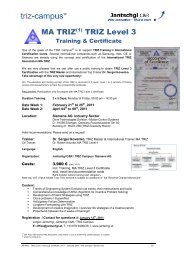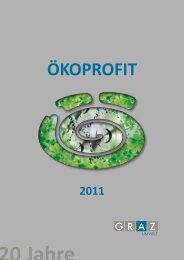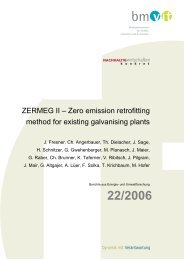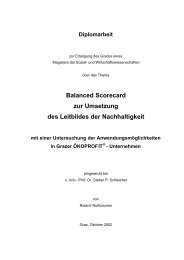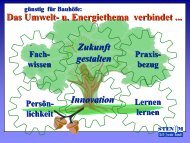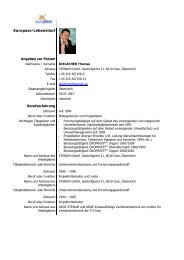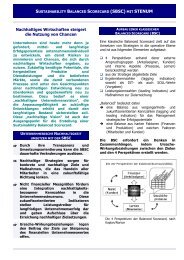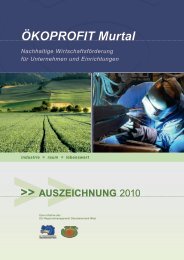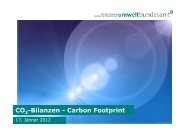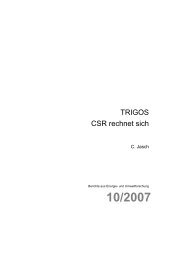Promoting Resource Efficiency in Small & Medium size ... - UNEP
Promoting Resource Efficiency in Small & Medium size ... - UNEP
Promoting Resource Efficiency in Small & Medium size ... - UNEP
Create successful ePaper yourself
Turn your PDF publications into a flip-book with our unique Google optimized e-Paper software.
Step 3: Benchmark Performance<br />
Benchmark<strong>in</strong>g is a process of compar<strong>in</strong>g your organisation’s<br />
operational formance to that of other organisations to become ‘best <strong>in</strong><br />
class’ and make cont<strong>in</strong>ual improvements. Benchmark<strong>in</strong>g is more than<br />
simply sett<strong>in</strong>g a performance reference or comparison; it is a way to<br />
facilitate learn<strong>in</strong>g for cont<strong>in</strong>ual improvement.<br />
Benchmarks for the selection of unit operations listed below, are<br />
<strong>in</strong>cluded <strong>in</strong> Chapter 8 of this handbook and <strong>in</strong> the electronic PRE-SME<br />
resource kit that accompanies this handbook:<br />
• Paper<br />
• Food process<strong>in</strong>g<br />
• Textile <strong>in</strong>dustry<br />
• Leather manufactur<strong>in</strong>g<br />
• Metal manufactur<strong>in</strong>g<br />
Benchmarks for the selection of unit operations listed below are<br />
<strong>in</strong>cluded <strong>in</strong> the accompany<strong>in</strong>g electronic PRE-SME resource kit:<br />
• Boilers<br />
• Cool<strong>in</strong>g towers<br />
• Sanitary use<br />
Step 4: Consider Options<br />
Many general approaches exist for identify<strong>in</strong>g water-sav<strong>in</strong>g opportunities.<br />
The <strong>in</strong>stallation of meters is the essential first step for monitor<strong>in</strong>g usage<br />
and provid<strong>in</strong>g motivation for operators to save water. In addition to fix<strong>in</strong>g<br />
leaks and stopp<strong>in</strong>g unnecessary use, the approaches listed below can be<br />
applied to become water efficient at any site.<br />
Sanitary/Sewage Uses:<br />
Often overlooked, are the water and cost sav<strong>in</strong>gs achievable by reduc<strong>in</strong>g<br />
sanitary and sewage water usage by employees at commercial and<br />
<strong>in</strong>dustrial facilities. While water efficiency measures should beg<strong>in</strong> with<br />
the most water-<strong>in</strong>tensive operations such as cool<strong>in</strong>g, clean<strong>in</strong>g, r<strong>in</strong>s<strong>in</strong>g<br />
and heat<strong>in</strong>g, many bus<strong>in</strong>esses miss the benefits of the ‘low-hang<strong>in</strong>g<br />
fruits’ that can be had <strong>in</strong> sanitary/sewage water consumption po<strong>in</strong>ts<br />
such as toilets, ur<strong>in</strong>als, s<strong>in</strong>k faucets and showers. Sanitary/sewage<br />
water use at <strong>in</strong>dustrial and commercial facilities may range from a few<br />
percent <strong>in</strong> a food process<strong>in</strong>g <strong>in</strong>dustry to more than 50% <strong>in</strong> an office<br />
sett<strong>in</strong>g. Average daily domestic demands <strong>in</strong> commercial and <strong>in</strong>dustrial<br />
sett<strong>in</strong>gs range between 75 and 130 litres per day per employee, and a<br />
sav<strong>in</strong>gs of 25 to 35% <strong>in</strong> this domestic usage is readily achievable.<br />
Boilers:<br />
Impurities <strong>in</strong> water add significantly to the cost of effectively operat<strong>in</strong>g<br />
a boiler. As steam is lost and water is added to the boiler to replace it,<br />
the concentration of impurities <strong>in</strong> the water ‘cycle up’, quickly mov<strong>in</strong>g<br />
beyond the concentration at which they can be adequately treated by<br />
chemicals. To prevent this, high-solids water must be bled from the<br />
boiler to ma<strong>in</strong>ta<strong>in</strong> a manageable level of solids <strong>in</strong> the boiler water. This<br />
process is known as ‘blowdown’. Unfortunately, blowdown – <strong>in</strong> addition<br />
to releas<strong>in</strong>g high solids – also releases money that has been <strong>in</strong>vested<br />
<strong>in</strong> the water. Specifically, the heat energy that brought the water up to<br />
temperature and the chemicals required to treat the water are lost dur<strong>in</strong>g<br />
the blowdown process.<br />
Improv<strong>in</strong>g condensate return is one way to m<strong>in</strong>imise blowdown and<br />
maximise cycles of concentration at which a boiler operates. By<br />
<strong>in</strong>creas<strong>in</strong>g condensate return, operators will decrease chemical usage,<br />
decrease blowdown and conserve the heat conta<strong>in</strong>ed <strong>in</strong> the hightemperature<br />
condensate.<br />
Cool<strong>in</strong>g:<br />
The use of open cool<strong>in</strong>g systems represents the largest use of<br />
water <strong>in</strong> <strong>in</strong>dustrial and commercial applications. Closed cool<strong>in</strong>g<br />
water cycles that, are back-cooled with cool<strong>in</strong>g towers, remove heat<br />
from air condition<strong>in</strong>g systems and from a wide variety of <strong>in</strong>dustrial<br />
processes that generate excess heat with less water. While all cool<strong>in</strong>g<br />
towers cont<strong>in</strong>ually cycle water <strong>in</strong> a closed loop, there is constant<br />
evaporation to take away the heat. Cool<strong>in</strong>g towers can consume 20<br />
to 30% or more, of a facility’s total water use. Optimis<strong>in</strong>g operation<br />
and ma<strong>in</strong>tenance of cool<strong>in</strong>g tower systems can offer facility managers<br />
significant sav<strong>in</strong>gs <strong>in</strong> terms of water consumption. To m<strong>in</strong>imise purge<br />
losses measure conductivity of the water <strong>in</strong> the sump. Try to m<strong>in</strong>imise<br />
the <strong>in</strong>put of salts with the cool<strong>in</strong>g water.<br />
Clean<strong>in</strong>g and R<strong>in</strong>s<strong>in</strong>g Applications:<br />
Most <strong>in</strong>dustrial and commercial bus<strong>in</strong>esses have a variety of clean<strong>in</strong>g<br />
and r<strong>in</strong>s<strong>in</strong>g applications that can consume large volumes of water.The<br />
water-efficiency techniques presented <strong>in</strong> Section 4.4 address general<br />
water efficiency for process changeovers, equipment clean-out, parts<br />
r<strong>in</strong>s<strong>in</strong>g, tank r<strong>in</strong>s<strong>in</strong>g, l<strong>in</strong>e flush<strong>in</strong>g, floor clean<strong>in</strong>g and other applications.<br />
They <strong>in</strong>clude dry pre-clean<strong>in</strong>g, collection and cascaded use of water,<br />
(automatic) control of the contents of impurities of wastewater e.g. by<br />
conductivity measurement and control of chemicals or detergents to<br />
make optimum use of water. CIP (Clean<strong>in</strong>g <strong>in</strong> place) – plants recover<br />
soda lyes for reuse and the last r<strong>in</strong>s<strong>in</strong>g water for pre-r<strong>in</strong>s<strong>in</strong>g of the next<br />
clean<strong>in</strong>g sequence.<br />
Reuse and Reclamation:<br />
Maximis<strong>in</strong>g utility of <strong>in</strong>-process water is accomplished by us<strong>in</strong>g it more<br />
than one time to do work. Water quality characteristics will determ<strong>in</strong>e<br />
if multifunctional use of <strong>in</strong>-process water is acceptable for achiev<strong>in</strong>g<br />
necessary product quality control/assurance. Fortunately, many watertreatment<br />
technologies can provide cost-effective opportunities to<br />
reduce water-supply demand and the resultant sav<strong>in</strong>gs can be used to<br />
justify capital costs. A simple approach <strong>in</strong> r<strong>in</strong>s<strong>in</strong>g is the use of counter<br />
low cascades. Depend<strong>in</strong>g on water-quality requirements for the stage of<br />
use, water may simply be recirculated or require only basic treatment<br />
such as solid settl<strong>in</strong>g, oil skimm<strong>in</strong>g and/or filtration us<strong>in</strong>g cartridge,<br />
bag, disk, <strong>in</strong>dex<strong>in</strong>g fabric or sand filtration.<br />
Water efficiency options for specific sectors with<strong>in</strong> an <strong>in</strong>dustrial plant<br />
and its processes are <strong>in</strong>cluded <strong>in</strong> detail <strong>in</strong> the electronic version of the<br />
toolkit.<br />
To ensure that water consumption is optimised, consumption should<br />
be monitored on a regular basis. It is helpful to <strong>in</strong>stall water meters<br />
for separate departments and even for <strong>in</strong>dividual processes or pieces<br />
of equipment. Whether this is feasible depends on the level of water<br />
consumption and the expected sav<strong>in</strong>gs <strong>in</strong> each <strong>in</strong>stance.<br />
Water consumption can be reduced by 10 – 50% simply by <strong>in</strong>creas<strong>in</strong>g<br />
employees’ awareness and by educat<strong>in</strong>g them on how to reduce<br />
unnecessary consumption.<br />
After the option generation (Plan) a draft implementation programme<br />
(Do) has to be made – see Basic Module PDCA.<br />
38



